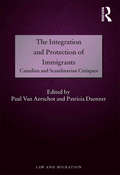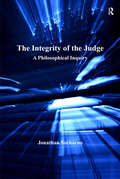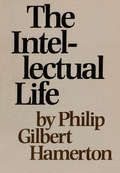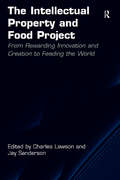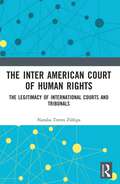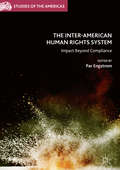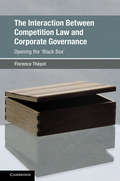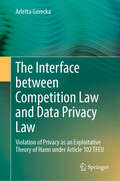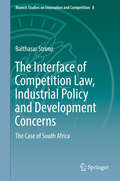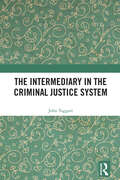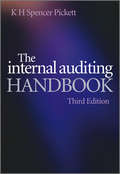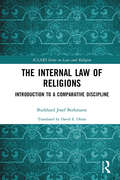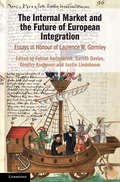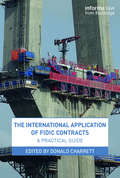- Table View
- List View
The Integration and Protection of Immigrants: Canadian and Scandinavian Critiques (Law and Migration)
by Paul Van Aerschot Patricia DaenzerIn Scandinavian countries immigration is a sensitive issue and legislators’ approach to the questions it has raised has varied over the years. Whatever immigrant and integration policies are adopted in a democratic society, it is clear that the legislation and the authorities have to ensure that the individual rights of the immigrants residing in its territory are respected. With Canada as a point of reference, this book draws attention to weaknesses in the regulation and implementation of integration provisions threatening the immigrants’ individual rights in the EU member states of Denmark, Finland and Sweden. The study challenges readers to critically review the meaning of rights and the notion of global caring. It takes a critical look at how vulnerable immigrants fare in a largely immigrant nation with a welfare capitalism legacy, when compared to three European nations which claim to embrace institutional welfare models. This book will be of great interest to scholars and decision-makers interested in Scandinavian or Canadian immigration and integration policies.
The Integration of European Financial Markets: The Regulation of Monetary Obligations (UT Austin Studies in Foreign and Transnational Law)
by Noah VardiThe last decade has seen the increasing integration of European financial markets due to a number of factors including the creation of a common regulatory framework, the liberalisation of international capital movements, financial deregulation, advances in technology and the introduction of the Euro. However, the process of integration has proceeded largely in the absence of any comprehensive legal regulation, and has rather been constructed on the basis of sectorial provisions dictated by the needs of cross-border transactions. This has meant that many legal barriers still remain as obstacles to complete integration. This book considers the discipline of monetary obligations within the wider context of financial markets. The book provides a comparative and transnational examination of the legal rules which form the basis of transactions on financial markets. Analysing the integration of the markets from a legal point of view provides an opportunity to highlight the role of globalisation as the key element favouring the circulation of rules, models, and especially the development of new regulatory sources. The book examines market transactions and the institutes at the root of these transactions, including the type of legislative sources in force and the subjects acting as legislators. The first part of the book concentrates on the micro-discipline of money, debts, payments and financial instruments. The second part goes on to analyse the macro-context of integration of the markets, looking at the persistence of legal barriers and options for their removal, as well as the development of new legal sources as a consequence of the transfer of monetary and political sovereignty. Finally, the book draws links between the two parts and assesses the consequences of the changes at the macro-level of regulation on the micro-level of legal discipline of monetary obligations, particularly focusing on the emergence and growing importance of soft law.
The Integrity of the Judge: A Philosophical Inquiry (Law, Justice And Power Ser.)
by Jonathan SoeharnoThere is no consensus among legal scholars on the meaning of judicial integrity, nor has legal scholarship yet seen a well-articulated discussion about the normative concept of judicial integrity. This book makes an analysis of the discourses on judicial integrity in judiciaries in both established and developing democracies. In the former, the rule of law is well-developed and trust in the judges is high, yet new demands for accountability emerge. In the latter, traditional integrity problems such as fraud and corruption take centre stage. The author argues that integrity must be understood both as professional virtue -discussed here through the lens of virtue ethical theory - and as the safeguarding of public trust, as understood through institutional theory. The Integrity of the Judge is a significant new work for legal theorists and philosophers, as well as scholars of legal and judicial ethics.
The Integrity of the Servant Leader
by Robert Sumi Dana Mesner-AndolšekThe impact of the global financial crisis is still being felt today and the deeply unethical behaviour of the top level leaders at those economic and financial organizations, that were at the heart of the crisis, has served to highlight the importance of integrity, and in particular the need for servant leadership, if we are to avoid another major catastrophe in the management of both commercial and non-profit organizations. Servant leadership has many features in common with transformational leadership but is primarily focused on caring about employees and their personal development. Ethical behaviour is one of the most important components of successful leadership yet this remains insufficiently investigated, especially from an interdisciplinary perspective. With the help of theory, empirical analysis and the relevant methodological apparatus, the authors fill the gap in the analysis of integrity and its impact on leadership and locate the significant factors which affect integrity in general. They develop and assess the forces that impact Servant Leadership style, as well as the ability to engender trust. As a starting point they make two assumptions: An important element in leading is the ethical dimension of leadership; The ratio of factors that affect leading and the servant leadership style is complex, but the integrity of leaders is the most important among them. The authors examine four integrated scientific areas: ethics and business ethics, human resource management and psychology and focus on the analysis of the process of leadership and the factors within that process of leading that influence its success and its ethical dimension.
The Intellectual Life
by Philip Gilbert HamertonThis classic exploration of the intellectual life has fully retained its unique value since initial publication in 1904, and it is a distinct satisfaction to present it for the pleasure and edification of discerning readers. No subsequent work fully compares to this rare mixture of personal insight, ethics, taste, psychology, and common sense. Philip Gilbert Hamerton bestowed upon it his long experience as a writer and artist, his enviable breadth of knowledge, and his elegance of literary style. The result is a remarkable work, expressing intimately the mind and personality of the author, yet universal in its application to all those with a love of intellectual pursuits. The publisher takes a great deal of pleasure in offering this work to the public.
The Intellectual Life
by Philip Gilbert HamertonThis classic exploration of the intellectual life has fully retained its unique value since initial publication in 1904, and it is a distinct satisfaction to present it for the pleasure and edification of discerning readers. No subsequent work fully compares to this rare mixture of personal insight, ethics, taste, psychology, and common sense. Philip Gilbert Hamerton bestowed upon it his long experience as a writer and artist, his enviable breadth of knowledge, and his elegance of literary style. The result is a remarkable work, expressing intimately the mind and personality of the author, yet universal in its application to all those with a love of intellectual pursuits. The publisher takes a great deal of pleasure in offering this work to the public.
The Intellectual Property and Food Project: From Rewarding Innovation and Creation to Feeding the World
by Jay Sanderson Charles LawsonThe relationship between intellectual property and food affects the production and availability of food by regulating dealings in products, processes, innovations, information and data. With increasingly intricate relations between international and domestic law, as well as practices and conventions, intellectual property and food interact in many different ways. This volume is a timely consideration and assessment of some of the more contentious and complex issues found in this relationship, such as genetic technology, public research and food security, socio-economic factors and the root cause of poverty and patent-busting. The contributions are from leading scholars in this emerging field and each chapter foregrounds some of the key developments in the area, exploring historical, doctrinal and theoretical issues in the field while at the same time developing new ideas and perspectives around intellectual property and food. The collection will be a useful resource in leading further discussion and debate about intellectual property law and food.
The Intellectual Property of Nations: Sociological and Historical Perspectives on a Modern Legal Institution
by Laura R. FordDrawing on macro-historical sociological theories, this book traces the development of intellectual property as a new type of legal property in the modern nation-state system. In its current form, intellectual property is considered part of an infrastructure of state power that incentivizes innovation, creativity, and scientific development, all engines of economic growth. To show how this infrastructure of power emerged, Laura Ford follows macro-historical social theorists, including Michael Mann and Max Weber, back to antiquity, revealing that legal instruments very similar to modern intellectual property have existed for a long time and have also been deployed for similar purposes. Using comparative and historical evidence, this groundbreaking work reflects on the role of intellectual property in our contemporary political communities and societies; on the close relationship between law and religion; and on the extent to which law's obliging force depends on ancient, written traditions.
The Intellectual Sword: Harvard Law School, the Second Century
by Bruce A. Kimball Daniel R. CoquilletteA history of Harvard Law School in the twentieth century, focusing on the school’s precipitous decline prior to 1945 and its dramatic postwar resurgence amid national crises and internal discord. By the late nineteenth century, Harvard Law School had transformed legal education and become the preeminent professional school in the nation. But in the early 1900s, HLS came to the brink of financial failure and lagged its peers in scholarly innovation. It also honed an aggressive intellectual culture famously described by Learned Hand: “In the universe of truth, they lived by the sword. They asked no quarter of absolutes, and they gave none.” After World War II, however, HLS roared back. In this magisterial study, Bruce Kimball and Daniel Coquillette chronicle the school’s near collapse and dramatic resurgence across the twentieth century. The school’s struggles resulted in part from a debilitating cycle of tuition dependence, which deepened through the 1940s, as well as the suicides of two deans and the dalliance of another with the Nazi regime. HLS stubbornly resisted the admission of women, Jews, and African Americans, and fell behind the trend toward legal realism. But in the postwar years, under Dean Erwin Griswold, the school’s resurgence began, and Harvard Law would produce such major political and legal figures as Chief Justice John Roberts, Justice Elena Kagan, and President Barack Obama. Even so, the school faced severe crises arising from the civil rights movement, the Vietnam War, Critical Legal Studies, and its failure to enroll and retain people of color and women, including Justice Ruth Bader Ginsburg. Based on hitherto unavailable sources—including oral histories, personal letters, diaries, and financial records—The Intellectual Sword paints a compelling portrait of the law school widely considered the most influential in the world.
The Intelligent Nation: How to Organise a Country (Citizenship and Sustainability in Organizations)
by John BeckfordThe Intelligent Nation proposes a systemic and radical transformation of the organisation, management, ownership and performance of the services of the state by capitalising on the potential offered by contemporary information capability and fulfilling the rights and obligations both to and of citizens. In this book, John Beckford shows how, by adopting the principles of an Intelligent Organisation, the state can thrive and meet the needs of its citizens. He proposes a complete rethink of the state as the enabler or provider of public services. In particular, he points to the failure of the public sector to significantly emulate the massive gains in productivity and customer focus experienced in both manufacturing and services (e.g. finance, retailing, insurance). Governance and all public services must be redesigned to align to the contemporary needs of the citizen and exploit the power of information to enable a transformation of their effectiveness, redefine efficiency and support human-based services in crucial areas. Each chapter provides the key learning points, a discussion of the problem in theory and practice, integrated case studies, and discussion points. Written in an accessible style, the book provides thought-provoking supplemental reading for masters and undergraduate students reading organisation theory, organisation development, political science, public administration, healthcare, information systems and business and management science.
The Inter American Court of Human Rights: The Legitimacy of International Courts and Tribunals
by Natalia Torres ZúñigaThis book provides a critical legal perspective on the legitimacy of international courts and tribunals. The volume offers a critique of ideology of two legal approaches to the legitimacy of the Inter-American Court of Human Rights (IACtHR) that portray it as a supranational tribunal whose last say on human rights protection has a transformative effect on the democracies of Latin America. The book shows how the discussion between these Latin American legal strands mirrors global trends in the study of the legitimacy of international courts related to the use of constitutional analogies and concepts such as the notion of judicial dialogue and the idea of democratic transformation. It also provides an in-depth analysis of how, through the use of those categories, legal experts studying the legitimacy of the IACtHR enact self-validation processes by making themselves the principal agents of transformation. These self-validation processes work as ideological apparatuses that reproduce and entrench the mindset that the legal discipline is a driving force of change in itself. Further, the book shows how profiling the Court as an agent of transformation diverts attention from the ways in which it has pursued a particular view of human rights and democracy in the region that creates and reproduces relations of inequality and domination. Rather than discarding the IACtHR, this book aims to de-centre the focus away from formal legal institutions, engaging with the idea that ordinary people can mobilise and define the content of law to transform their lives and territories. The book will be a valuable resource for scholars working in the areas of human rights law, law, public international law, legal theory, constitutional law, political science and legal philosophy.
The Inter-American Human Rights System: Impact Beyond Compliance (Studies of the Americas)
by Par EngstromThis volume brings together innovative work from emerging and leading scholars in international law and political science to critically examine the impact of the Inter-American Human Rights System (IAHRS). By leveraging a variety of theoretical frameworks and methodological approaches, the contributors assess the impact of the IAHRS on domestic human rights change in Latin America. More specifically, the book provides a nuanced analysis of the System’s impact by examining the ways in which the IAHRS influences domestic actors and political institutions advancing the realisation of human rights. This work will be of interest to students and scholars of human rights and Latin American politics, as well as to those engaged with the nexus of international law and domestic politics and the dynamics of international and regional institutions.
The Interaction Between Competition Law and Corporate Governance: Opening the 'Black Box' (Global Competition Law and Economics Policy)
by Florence ThépotFlorence Thépot provides the first systematic account of the interaction between competition law and corporate governance. She challenges the 'black box' conception of the firm- or 'undertaking' - in competition law, as applied to increasingly complex corporate relations. The book opens the 'black box' of the firm to understand the internal drivers of collusive behaviour, and proposes a unified approach to cartel enforcement, based on the agency theory. It explores key issues including corporate compliance programmes, the attribution of liability in corporate groups, and structural links between competitors, and should be read by anyone interested in how the evolution of the corporate landscape impacts competition law.
The Interaction between World Trade Organisation: The Constrained Openness of WTO Law (A Prologue to a Theory) (Routledge Research in International Economic Law)
by Ronnie R.F. YearwoodInternational legal scholarship is concerned with the fragmentation of international law into specialised legal systems such as trade, environment and human rights. Fragmentation raises questions about the inter-systemic interaction between the various specialised systems of international law. This study conceptually focuses on the interaction between World Trade Organisation (WTO) law and external international law. It introduces a legal theory of WTO law, constrained openness, as a way to understand that interaction. The idea is that WTO law, from its own internal point of view, constructs its own law. The effect is that external international law is not incorporated into WTO law wholesale, but is (re)constructed as WTO law. It follows that legal systems do not directly communicate with each other. Therefore, to influence WTO law, an indirect strategic approach is required, which recognises the functional nature of the differentiated systems of the fragmented international legal system.
The Interbellum Constitution: Union, Commerce, and Slavery in the Age of Federalisms (Yale Law Library Series in Legal History and Reference)
by Alison L. LaCroixA synthesis of legal, political, and social history to show how the post-founding generations were forced to rethink and substantially revise the U.S. constitutional vision Between 1815 and 1861, American constitutional law and politics underwent a profound transformation. These decades of the Interbellum Constitution were a foundational period of both constitutional crisis and creativity. The Interbellum Constitution was a set of widely shared legal and political principles, combined with a thoroughgoing commitment to investing those principles with meaning through debate. Each of these shared principles—commerce, concurrent power, and jurisdictional multiplicity—concerned what we now call &“federalism,&” meaning that they pertain to the relationships among multiple levels of government with varying degrees of autonomy. Alison L. LaCroix argues, however, that there existed many more federalisms in the early nineteenth century than today&’s constitutional debates admit. As LaCroix shows, this was a period of intense rethinking of the very basis of the U.S. national model—a problem debated everywhere, from newspapers and statehouses to local pubs and pulpits, ultimately leading both to civil war and to a new, more unified constitutional vision. This book is the first that synthesizes the legal, political, and social history of the early nineteenth century to show how deeply these constitutional questions dominated the discourse of the time.
The Interconnection of the EU Regulations Brussels I Recast and Rome I: Jurisdiction and Law (Short Studies in Private International Law)
by Christoph SchmonThis book deals with the interconnection between the Brussels I Recast and Rome I Regulations and addresses the question of uniform interpretation. A consistent understanding of scope and provisions is suggested by the preamble of the Rome I Regulation. Without doubt, it is fair to presume that the same terms bear the same meaning throughout the Regulations.The author takes a closer look at the Regulations’ systems, guiding principles, and their balance of flexibility and legal certainty. He starts from the premise that such analysis should prove particularly rewarding as both legal acts have their specific DNA: The Brussels I Recast Regulation has a procedural focus when it governs the allocation of jurisdiction and the free circulation of judgments. The multilateral rules under the Rome I Regulation, by contrast, are animated by conflict of laws methods and focus on the delimitation of legal systems.This fourth volume in the Short Studies in Private International Law Series is primarily aimed at legal academics in private international law and advanced students. But it should also prove an intriguing read for legal practitioners in international litigation.Christoph Schmon is a legal expert in the fields of Private International Law, Consumer Law, and Digital Rights. After serving in research positions at academic institutes in Vienna and London, he focused on EU policy and law making. He is appointed expert of advisory groups to the EU Commission.
The Interdependence of the Convention on the Rights of the Child: Understanding the Relationship of the Right to Play with other Convention Rights
by Naomi LottThe book critically engages with the right to play and other Convention rights to explore their interdependence and interconnectivity. The book brings together experts across various children&’s rights topics and invites them to consider the intersections of their work with the child&’s right to play. It furthers the understanding and implementation of the right to play as this novel area of research develops. The book demonstrates both the interdependence of the rights within the Convention, and the unique and critical role of the right to play in achieving the aims of the Convention and the rights therein. It also extends the theoretical, methodological and critical scope of the discipline by considering children&’s rights in this interdependent manner. The contributions to this edited collection explore the role of the right to play in meeting obligations pertaining to the digital environment, identity rights, education, climate change and environmental health, refugees, girls&’ rights, social protection, healthcare and disability, and vice versa. By drawing together original and creative approaches to a number of pressing social questions and issues relating to human rights, this book has tangible application for developing both the content of the right to play and the potentials of this right for the wider child rights project. Furthermore, this book is pioneering in the field of children&’s rights in two key ways. Not only does it serve to contribute to filling a significant gap in the literature on the right to play, but it also stands as a crucial example of interdisciplinary legal research. Such an approach is critical for the field of children&’s rights due to the nature of childhood and the multidisciplinary relevance of children&’s rights and children&’s issues. This book thus serves as an example to push the field to be more contextual and interdisciplinary.
The Interdependent Organization: The Path to a More Sustainable Enterprise
by Rexford H. DramanThe Interdependent Organization provides its readers with a template for the development of an individualized transition plan to guide their journey toward becoming more organizationally sustainable. We as humans tend to rely on our current set of assumptions when we evaluate our actions and their potential impact on the future. With today’s ever-increasing rate of change in technology, our access to information, and cultural interactions (interdependence) around the world, the reliance on old ways of thinking (linear) will not allow us to effectively transition into the systems-based world of tomorrow. The Interdependent Organization presents a deeper understanding of the financial, operational, and cultural crossroads we are facing as a planet, and introduces a systems-based transitional path that individuals, organizations, and societies can draw on to move towards a more holistic and sustainable future. The book provides readers with the necessary understanding and insight into systems, systems-thinking, and the use of systems-based business tools to guide the sustainability journey while producing a positive impact to the organization’s bottom-line, its employee engagement, and its stakeholders’ expectations in each of the journey's three stages. The journey begins with the adoption of simple yet powerful systems-based tools for managing the organization’s operations and projects. These proven tools provide increased productivity with a proven bottom-line improvement that exceeds 30%. This introduction to systems-based tools and thinking provides the organization with the time to become more familiar with this new way of thinking and making business decisions before they expand their exposure to broader, more complex systems-based and sustainable practices. The second stage of this journey is focused on introducing new tools and practices to insure a consistent set of measures are used across the organization. The third and final stage focuses on aligning the organization’s people-management practices.
The Interface between Competition Law and Data Privacy Law: Violation of Privacy as an Exploitative Theory of Harm under Article 102 TFEU
by Arletta GoreckaThis book assesses the extent to which the current EU competition law framework can incorporate privacy-related theories of harm. Specifically, it evaluates the importance of protecting individual privacy in establishing exploitative abuse of dominance under Article 102 TFEU. The book explores scenarios where Big Tech firms exploit their dominant positions through excessive data collection or limiting consumer choice, thereby harming competition and directly affecting user well-being. It posits that zero-priced business models of online platforms and the ubiquity of data generation create strong incentives to acquire and process consumer data, which can harm digital consumers' privacy. The book assesses how the existing EU competition law framework can address and regulate exploitative abuses, particularly concerning the protection of individuals' privacy. Importantly, this book argues that competition law might recognize privacy-related harms as forming exploitative theories of harm under Article 102 TFEU. Article 102 TFEU offers flexibility and can be applied to a broader range of unfair practices. Article 102 TFEU emphasizes enhanced transparency and predictability, aiming to prevent abuses of dominant positions that could undermine healthy competition, to the detriment of consumers and other market participants. This book provides a comprehensive analysis of how the existing EU competition law framework can address the evolving challenges at the intersection of competition and privacy, ultimately seeking to protect consumer welfare and ensure fair competition in the digital economy.
The Interface of Competition Law, Industrial Policy and Development Concerns: The Case of South Africa (Munich Studies on Innovation and Competition #8)
by Balthasar StrunzThis book analyses essential concepts of competition law and industrial policy, and shows where the two areas clash with and complement each other, respectively. The discussion takes place in the context of developing countries, taking into consideration their realities and specific needs. South Africa serves as a real-world example for competition law that goes beyond the notion of consumer welfare. An in-depth analysis of the enforcement of South African law illustrates how the law is used both to combat the negative effects of past industrial policy, and to accommodate current economic and social needs.The book is intended for all readers with an interest in the enforcement of competition law in developing countries. It will particularly benefit those who want to learn about unorthodox approaches that integrate the concept of “public interest” and social imperatives into the application of competition law.
The Intermediary in the Criminal Justice System
by John TaggartThis book undertakes a sociolegal examination of the intermediary role within the criminal justice system.The intermediary special measure is one of the most innovative and controversial developments in the history of English criminal procedure. But what does the role actually involve? That is the central question explored in this book. Despite increased academic attention into this new criminal justice actor, the content of the intermediary role remains unclear. Based centrally on empirical data gathered in England and Wales and Northern Ireland, but also drawing upon comparative material from other jurisdictions, the book examines how those executing the intermediary role understand its work and how other criminal justice actors perceive it. The book then uses this as the basis for generating a theory of the intermediary role and its scope and content. It also considers the future of the role and its integration into the criminal justice system.This book will appeal to those researching and studying in the areas of sociolegal studies, criminal law and criminology, as well as lawyers, judges, intermediaries and policy makers working in relevant areas.
The Internal Auditing Handbook
by K. H. PickettThe first edition of The Internal Auditing Handbook received wide acclaim from readers and became established as one of the definitive publications on internal auditing. The second edition was released soon after to reflect the rapid progress of the internal audit profession. There have been a number of significant changes in the practice of internal auditing since publication of the second edition and this revised third edition reflects those changes. The third edition of The Internal Auditing Handbook retains all the detailed material that formed the basis of the second edition and has been updated to reflect the Institute of Internal Auditor's (IIA) International Standards for the Professional Practice of Internal Auditing. Each chapter has a section on new developments to reflect changes that have occurred over the last few years. The key role of auditors in reviewing corporate governance and risk management is discussed in conjunction with the elevation of the status of the chief audit executive and heightened expectations from boards and audit committees. Another new feature is a series of multi-choice questions that have been developed and included at the end of each chapter.This edition of The Internal Auditing Handbook will prove to be an indispensable reference for both new and experienced auditors, as well as business managers, members of audit committees, control and compliance teams, and all those who may have an interest in promoting corporate governance.
The Internal Law of Religions: Introduction to a Comparative Discipline (ICLARS Series on Law and Religion)
by Burkhard Josef BerkmannComparative law of religions has developed in recent years as a new discipline at the intersection of legal and religious science, of theology and anthropology. This book presents a systematic theoretical basis for this new discipline. While law is mostly associated with the state, many religions also have their own internal law. These internal legal norms are aimed at a particular form of behaviour on the part of believers. They therefore play a particular role in conflicts arising today between certain religious forms of behaviour. The comparison of the internal law of religions serves to establish and explain the commonalities and differences between various religious legal traditions. The religions examined here include: the law of Christian denominations, Jewish law, Islamic law, Hindu law, Buddhist law, and other religious legal systems. The work assesses six current approaches to the comparative law of religions, evaluating their strengths and weaknesses, leading to the development of a new approach. The book discusses the role of religious law in state law and looks to likely future developments. The work will be essential for those interested in the administration of justice and politics, for those professions where intercultural competence is required, and for interreligious dialogue.
The Internal Market and the Future of European Integration: Essays in Honour of Laurence W. Gormley
by Gareth Davies Dimitry Kochenov Fabian Amtenbrink Justin LindeboomThis collection marks the rich legacy of Professor Laurence W. Gormley's scholarship in the field of EU internal market law, providing a definitive critical appraisal of all the key aspects of the internal market, with an emphasis on goods and judicial protection; Professor Gormley's expert fields. Forty chapters deal with constitutional aspects of the EU internal market, the free movement of goods, persons and services, EMU, public procurement and competition law, institutional and procedural dimensions, and the EU's external relations, which includes matters relating to Brexit. The broad theme of the book, reflecting the many interests of Professor Gormley, will appeal to scholars, students and practicing lawyers. Dealing with both classic, foundational aspects of the EU internal market as well as highly topical matters, such as Brexit, this book will be a most welcome addition to every engaged legal scholar's library, thereby celebrating the legacy of a mentor and dear friend.
The International Application of FIDIC Contracts: A Practical Guide
by Donald CharrettFIDIC contracts are the most widely used contracts for international construction around the world and are used in many different jurisdictions, both common law and civil law. For any construction project, the General Conditions of Contract published by FIDIC need to be supplemented by Particular Conditions that specify the specific requirements of that project. The International Application of FIDIC Contracts: A Practical Guide provides readers with detailed guidance and resources for the preparation of the Particular Conditions that will comply with the requirements of the applicable laws that apply to the site where the work is carried out, and for the governing law of the contract, for a number of the jurisdictions in which FIDIC contracts are used. This book is essential reading for construction professionals, lawyers and students of construction law.
